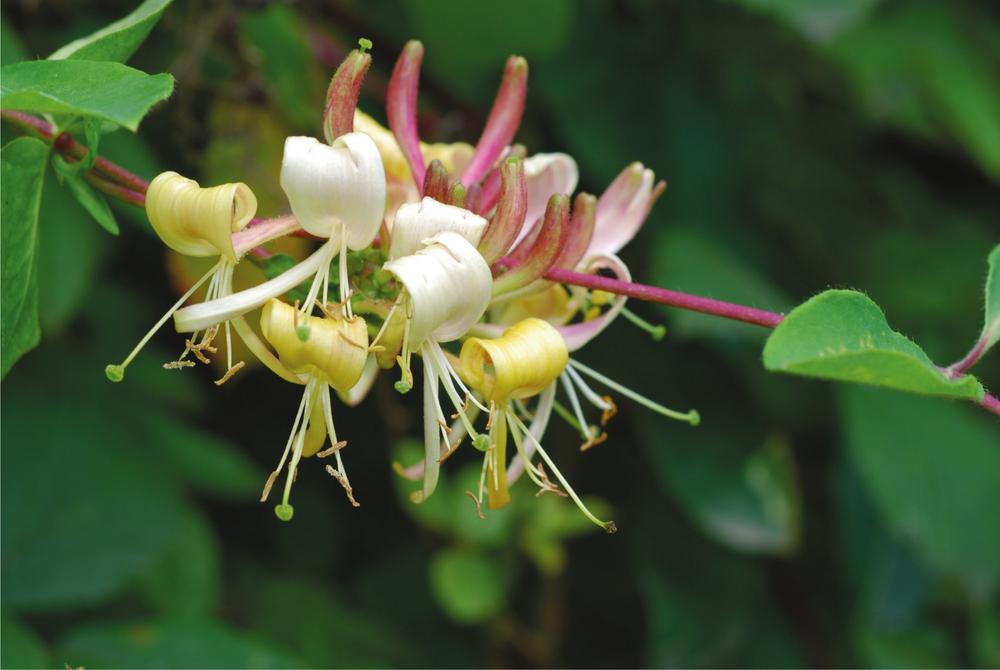Honeysuckle is esteemed for its superb scent and lovely flowers but should also be valued as a cooling herb. It has benefits for menopausal hot flushes, ’flu, fevers, heat stroke, urinary tract infections and other hot conditions. The flowers have similar qualities to aspirin and are strongly antiseptic, being effective against a range of micro-organisms.

Caprifoliaceae Honeysuckle family
Description: A twining deciduous shrub with fragrant white, yellow and red flowers followed by red berries.
Habitat: Hedgerows, woodland and scrub.
Distribution: Found throughout the British Isles.
Related species: There are around 180 honeysuckle species worldwide, several with medicinal qualities. Japanese honeysuckle (L. japonica) is a popular garden plant now naturalised in Australia and North America, with similar medicinal uses to woodbine.
Parts used: Flowers, harvested when in bloom during late spring, summer or autumn.
Honeysuckle must be among the best-loved of wild and garden plants. It has the sweetest and most intoxicating of fragrances, and its attractive white, yellow and red flowers keep on blooming through spring and summer. It forms lovely bowers that offer dappled shade around cottage front doors; it is irresistible to the bees and hawk moths that pollinate it; and honeysuckle’s scarlet berries in autumn are food for many birds.
Its intertwining habit has made it the very symbol of love in many cultures. Honeysuckle flowers were once thought too dangerous to keep indoors because the scent would give forbidden thoughts to young ladies. Our national bard knew well its mythic power, using it as an image of lovers sleeping enfolded in each other’s arms in A Midsummer Night’s Dream.
Honeysuckle was probably more common in Shakespeare’s day, as England was so heavily wooded. The very old common names woodbine or woodbind recall this origin, and the twining habit.
Modern foresters are not quite so taken with the way honeysuckle twists around hazel stems, leaving permanent grooves that lower the commercial value. These twisted hazel stems, though, were once highly prized for making into twirly walking sticks that were said to help suitors win the woman of their dreams.
The Elizabethans would have been as interested in honeysuckle’s medicinal properties as its beauty or romantic associations. They would not have known that its leaves and flowers are rich in salicylic acid, a compound similar to aspirin. But they would have been well aware that an infusion of the flowers or leaves was good for headaches, fevers, bronchial complaints and rheumatism, as it is today.
Modern herbalists favour the flowers over the leaves, but the bitter berries are seldom used, except for serious vomiting or diarrhoea. Any of the yellow-flowered varieties of honeysuckle are effective in treating heat conditions, perhaps the principal benefit of the plant today. The effect is cooling for menopausal hot flushes, fevers, sunstroke and urinary tract infections.

Honeysuckle is also used for spasm in the respiratory system in such conditions as asthma, croup and bronchitis. It is antiseptic and effective against many micro-organisms, reinforcing its value for sore throats and respiratory problems.
A traditional Chinese formula, shuang huang lian, mixes honeysuckle, forsythia and skullcap for respiratory complaints. James Duke, doyen of American herbalists, rates honeysuckle second only to eucalyptus for sore throats.
We favour the flowers steeped in honey, though a tea of the dried flowers is also good, drunk often or poured into a hot bath.
Honeysuckle flowers infused in honey or glycerine
Pick honeysuckle flowers and buds and put them in a jar, then fill it up with runny honey or vegetable glycerine. Put the jar on a sunny windowsill or in another warm place and leave it for two weeks. You may need to push the flowers down into the liquid every few days to keep them covered, or they will go brown. Strain, bottle and label.
Dose: 1 teaspoonful as needed for sore throats, or 3 times a day.